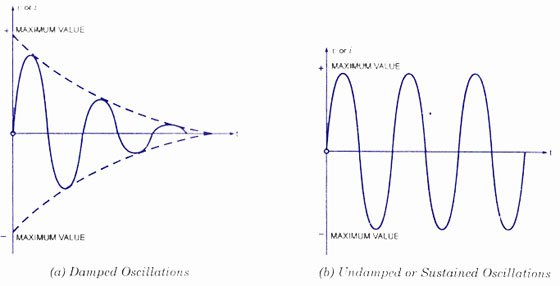Damped Oscillation and Forced Oscillation are two different phenomena that can affect the behavior of oscillatory systems.

Damped Oscillation
Definition: Damped oscillation refers to the decay of the amplitude of an oscillating system over time due to the presence of a damping force. The damping force acts against the motion of the system, gradually reducing its energy and causing the oscillations to decrease in magnitude.
Characteristics:
- Energy Loss: In damped oscillation, energy is continuously lost from the system, leading to a decrease in amplitude.
- Exponential Decay: The amplitude of the oscillations typically follows an exponential decay function over time.
- Critical Damping: Critical damping is a special case where the system returns to its equilibrium position as quickly as possible without oscillating back and forth.
Examples:
- A swinging pendulum in a medium with air resistance experiences damped oscillation.
- A mass-spring system with a damping force will exhibit damped oscillation.
Forced Oscillation
Definition: Forced oscillation occurs when an external force is applied to an oscillating system, causing it to oscillate with a frequency that is not necessarily its natural frequency. The external force periodically drives the system, influencing its motion.

Characteristics:
- External Force: The oscillating system is subject to an external force, usually periodic, that imposes a specific frequency on the system.
- Amplitude Response: The system responds to the external force, and its amplitude may increase, decrease, or reach a steady state, depending on the relationship between the driving frequency and the natural frequency of the system.
- Resonance: Resonance occurs when the driving frequency matches the natural frequency of the system, resulting in a significant increase in amplitude.
Examples:
- Pushing a child on a swing periodically to maintain its oscillations is an example of forced oscillation.
- An AC circuit driven by an external voltage source is an example of forced oscillation in electrical systems.
Connection to Waves
In the context of waves, both damped and forced oscillations can be relevant:
- Damped Waves: In certain media, waves can experience damping due to factors like viscosity, leading to a gradual decrease in wave amplitude over distance.
- Forced Waves: External forces, such as periodic driving, can influence the behavior of waves. For example, seismic waves generated by periodic ground motion during an earthquake can force oscillations in structures.
Understanding these concepts is crucial for analyzing the behavior of oscillatory systems, whether they involve mechanical vibrations, electromagnetic waves, or other types of waves in physics.
Comparison
| Characteristic | Damped Oscillation | Forced Oscillation |
|---|---|---|
| Definition | Decay of amplitude over time due to damping force/factor. | Oscillation induced by an external periodic force. |
| Energy Loss | Continuous loss of energy, resulting in decreasing amplitude. | Energy input from an external force; may lead to energy gain or loss. |
| Amplitude Behavior | Amplitude decreases over time (exponential decay). | Amplitude response depends on the driving frequency; may increase, decrease, or stabilize. |
| Natural Frequency | Determines the inherent oscillation frequency of the system. | Still relevant but can be influenced by external force. |
| Resonance | Generally avoids resonance to prevent excessive oscillations. | Resonance may occur if the driving frequency matches the natural frequency. |
| Examples | – Pendulum in the air with air resistance, Mass-spring system with damping. | – Pushing a child on a swing, AC circuit driven by an external voltage source. |
These characteristics highlight the key differences between damped and forced oscillations, including their underlying causes, energy considerations, amplitude behaviors, and the role of external forces. Thanks for reading the article on Damped and Forced Oscillation.